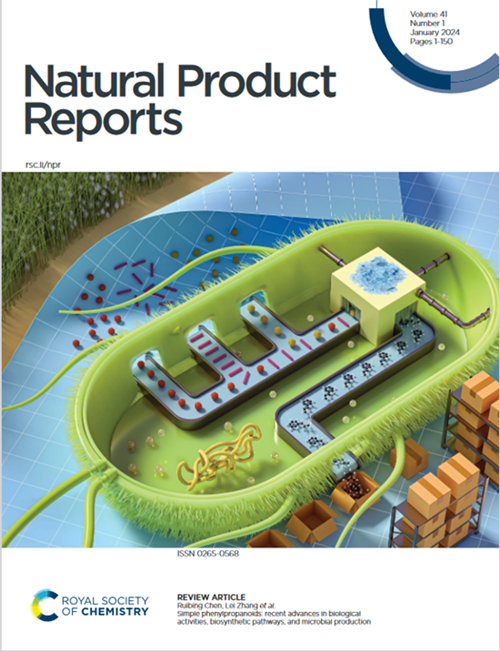Volatile organic compounds (VOCs) in terrestrial extreme environments: implications for life detection beyond Earth
IF 10.6
1区 化学
Q1 BIOCHEMISTRY & MOLECULAR BIOLOGY
引用次数: 0
Abstract
Covering: 1961 to 2024
Discovering and identifying unique natural products/biosignatures (signatures that can be used as evidence for past or present life) that are abundant, and complex enough that they indicate robust evidence of life is a multifaceted process. One distinct category of biosignatures being explored is organic compounds. A subdivision of these compounds not yet readily investigated are volatile organic compound (VOCs). When assessing these VOCs as a group (volatilome) a fingerprint of all VOCs within an environment allows the complex patterns in metabolic data to be unravelled. As a technique already successfully applied to many biological and ecological fields, this paper explores how analysis of volatilomes in terrestrial extreme environments could be used to enhance processes (such as metabolomics and metagenomics) already utilised in life detection beyond Earth. By overcoming some of the complexities of collecting VOCs in remote field sites, a variety of lab based analytical equipment and techniques can then be utilised. Researching volatilomics in astrobiology requires time to characterise the patterns of VOCs. They must then be differentiated from abiotic (non-living) signals within extreme environments similar to those found on other planetary bodies (analogue sites) or in lab-based simulated environments or microcosms. Such an effort is critical for understanding data returned from past or upcoming missions, but it requires a step change in approach which explores the volatilome as a vital additional tool to current ‘Omics techniques.

陆地极端环境中的挥发性有机化合物(VOCs):对地球以外生命探测的影响。
覆盖范围:1961 年至 2024 年发现和识别独特的天然产品/生物特征(可用作过去或现在生命证据的特征)是一个多方面的过程,这些天然产品/生物特征数量丰富,而且足够复杂,能够有力地证明生命的存在。正在探索的生物特征的一个独特类别是有机化合物。在这些化合物中,挥发性有机化合物(VOCs)是一个尚未被研究的细分类别。当把这些挥发性有机化合物作为一个群体(挥发物)进行评估时,环境中所有挥发性有机化合物的指纹就可以揭示出代谢数据的复杂模式。作为一种已经成功应用于许多生物和生态领域的技术,本文探讨了如何利用对陆地极端环境中挥发性有机物的分析来加强已经用于地球以外生命探测的过程(如代谢组学和元基因组学)。通过克服在偏远野外地点收集挥发性有机化合物的一些复杂性,可以利用各种实验室分析设备和技术。研究天体生物学中的挥发性有机物需要时间来确定挥发性有机物的形态特征。然后,必须在类似于其他行星体(模拟地点)或实验室模拟环境或微观世界的极端环境中,将它们与非生物(非生物)信号区分开来。这样的努力对于理解过去或即将进行的任务所返回的数据至关重要,但这需要方法上的一步改变,将挥发物群作为当前 "全息技术 "的重要补充工具进行探索。
本文章由计算机程序翻译,如有差异,请以英文原文为准。
求助全文
约1分钟内获得全文
求助全文
来源期刊

Natural Product Reports
化学-生化与分子生物学
CiteScore
21.20
自引率
3.40%
发文量
127
审稿时长
1.7 months
期刊介绍:
Natural Product Reports (NPR) serves as a pivotal critical review journal propelling advancements in all facets of natural products research, encompassing isolation, structural and stereochemical determination, biosynthesis, biological activity, and synthesis.
With a broad scope, NPR extends its influence into the wider bioinorganic, bioorganic, and chemical biology communities. Covering areas such as enzymology, nucleic acids, genetics, chemical ecology, carbohydrates, primary and secondary metabolism, and analytical techniques, the journal provides insightful articles focusing on key developments shaping the field, rather than offering exhaustive overviews of all results.
NPR encourages authors to infuse their perspectives on developments, trends, and future directions, fostering a dynamic exchange of ideas within the natural products research community.
 求助内容:
求助内容: 应助结果提醒方式:
应助结果提醒方式:


